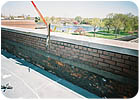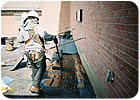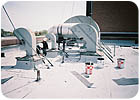Technical Details: The Ties That Bind
Not all building leaks are roof leaks. The roof system ties into, adjoins and houses several other building components that, if not properly waterproofed, will contribute to moisture infiltration.

Not all building leaks are roof leaks. The roof system ties into, adjoins and houses several other building components that, if not properly waterproofed, will contribute to moisture infiltration. Since these components interact with the roof system to some degree, it is in the roofing contractor's best interest to inspect these areas in the course of any roof reviews. Observed openings, material deterioration and improper detailing or workmanship at any of these locations should be pointed out to the building owner so that these problems can be properly addressed.
HVAC units and mechanical equipment are often the source of leaks that are mistaken as roof leaks. This is primarily due to the number of potential leakage points associated with this equipment. The housing is typically constructed of fabricated sheet metal and sealant applications are used as the waterproofing protection at joints and enclosure openings. How many service calls has your company completed where the source of the leak was an open mechanical door? Mechanical equipment often involves gaskets, drip pans, pitch pans and metal flashings, which occasionally open and allow moisture to enter the building.
The roof system also comes in direct contact with other accessory items that are not always properly waterproofed. Many of these items are installed after the roof system has been completed, usually by contractors other than roofers. For instance, doorways provide several openings that - if not properly terminated - could be sources for moisture infiltration into the building. A doorway to a mechanical room or penthouse could have sealant separation at joints or openings formed by rust or corrosion. A door that does not adequately close could provide ample opportunity for water to collect on the unprotected floor of the penthouse area - water that could eventually find its way into the interior space. To eliminate this concern, thresholds should be applied at door openings to prevent wind and water from entering the building.
Building signs are often secured to exterior walls or have bracing mounted to the roof side of a parapet wall. Attachment methods rarely include provisions for waterproofing the anchors. The same is true of lightning protection equipment that is not installed in conjunction with a roofing project. The protection clips are often mounted through the roof membrane or at parapet coping without protection. Lighting fixtures, security cameras and electrical equipment can fall into the same category.

Moisture entry in masonry exteriors is probable at hairline cracks, settlement cracks, joint separations and pores. These problems can become more acute as the substrate ages and weathers. Moisture entry contributes to masonry destruction from cracking, efflorescence, and soiling and staining of light-colored surfaces.
The process of tuck-pointing repairs deteriorated mortar joints. Prior to the tuck-pointing process, all surface contaminants should be removed. The existing mortar should be removed to a minimum of 3⁄8 to 1⁄2 inch. A maximum 1-inch opening should be removed on severely damaged joints. Mortar removal can be completed with hand or power tools, such as hand grinders. It is imperative that joint lines are maintained in a straight condition and that no masonry is damaged during the process. This may eliminate the use of power tools, particularly on historic structures.
Once the old mortar is removed, the surface should be thoroughly cleaned of all dust, residue and contaminants. Loose particles of residue left on the joint surface will have a negative effect on mortar bonding and will contribute to loss of adhesion. The most effective form of residue removal is by spraying the joints with compressed air. When the surface is adequately cleaned, the existing mortar cavities should be wetted. This prevents premature drying and curing, which results in structurally weak joints.
Tuck-pointing should be completed using pre-mixed materials that are specially formulated for these types of applications. Regular masonry mortar may not provide sufficient performance. Use of specially formulated materials is important to ensure effective bonding and proper waterproofing, and to control the compressive strength of the material. Materials higher in compressive strength than the masonry units are detrimental because if the joints are stronger than the masonry units, spalling of the masonry units will occur during movement. The mortar should be prepared with dry mixed cement, sand-based products, and mixed with only clean water in the amount specified by the manufacturer.
The application should be completed with a convex jointing tool that compresses the mortar tightly against the sides of the masonry units and in the joints. Excess mortar should be applied into the joints to ensure proper fill to capacity. Excess materials and fins are brushed or scraped off the joints right after application and the joints should be struck to provide a concave finish. Tuck-pointing should not be completed in wet conditions or when the ambient outside temperature is lower than 40 degrees Fahrenheit.

Preventive measures required over porous materials typically include the application of water repellents. Water repellents are typically manufactured with a monomeric or polymeric resin that is dissolved into an organic solvent or water. They are defined commercially by their most active resin, such as acrylic, silane, state, etc. Exterior water repellents can be classified as sealers (film formers) or penetrants.
Sealers fill the masonry pores and form a continuous film over the masonry material. These products often provide a gloss or sheen over the surface and they are routinely specified by architects to intensify the color of the substrate. Acrylic resins are commonly used in sealers.
Penetrants line the masonry pores and form a protective barrier against moisture infiltration into the substrate. Silanes and siloxane resins are typically used in penetrants because they contain catalysts that promote the proper reactions with the masonry material.
Repellants should never be applied as repair treatments of cracks, voids, damaged masonry or any other deformations. Repairs of this nature require the use of proper patching materials. Furthermore, all required repairs should be completed prior to the application of water repellants.
In remedial applications, existing repellants must be adequately removed from the surface. Some repellants do not adhere properly to new masonry mortars or extensive tuck-pointing repairs.
A commonly recognized principle is that repellant treatments that yield a substantial reduction in the water vapor transmission rate of the substrate should be avoided. The concern in these uses is that the repellants can trap moisture in the substrate, contributing to deterioration after freeze-thaw or wet-dry cycles. Common deformations associated with these phenomena include spalling, cracking and effloresence, the accumulation of salts beneath the masonry surface

For application over new concrete walls, it is essential that the concrete is dry and properly cured for a minimum of 28 days. Application over uncured concrete or damp surfaces leads to formation of a white haze.
Some water repellants - such as silanes and siloxanes - perform better when they are applied over damp surfaces. However, acrylics require a thoroughly dry surface. Consult the repellant manufacturer's technical personnel for proper application requirements.
Repellants are temperature sensitive and should be applied in the proper outdoor conditions. Most manufacturers require that the ambient temperature be between 40 degrees and 100 degrees during application and for a 24- to 48-hour period after application. Application should be completed on dry, non-windy days.
The repellant material should be applied in a continuous flow with an even and uniform application rate throughout the surface. The material coverage rate must be in accordance with the manufacturer's requirements, and it should be noted that too much or too little coverage could result in a poor application. The coverage rate will vary depending on the type and condition of the substrate, as well as its texture and porosity. Follow the manufacturer's requirements for the number of applications; some products require only one application, while others require two applications.
Once the application has been completed, and the material properly cures, a water test should be conducted to determine the success of the application.
Exterior component flashing problems also occur due to the fact that several different trades can be employed to construct portions of the façade. The importance of productivity often takes precedence over providing accurate conditions for the subsequent trades. For instance, masonry contractors may not adequately clean mortar droppings on flashings in cavity walls or in weep holes - two conditions that could lead to eventual moisture infiltration. Other common flashing application problems include:

Not all building leaks are roof leaks. The roof system ties into, adjoins and houses several other building components that, if not properly waterproofed, will contribute to moisture infiltration. Since these components interact with the roof system to some degree, it is in the roofing contractor's best interest to inspect these areas in the course of any roof reviews. Observed openings, material deterioration and improper detailing or workmanship at any of these locations should be pointed out to the building owner so that these problems can be properly addressed.
HVAC units and mechanical equipment are often the source of leaks that are mistaken as roof leaks. This is primarily due to the number of potential leakage points associated with this equipment. The housing is typically constructed of fabricated sheet metal and sealant applications are used as the waterproofing protection at joints and enclosure openings. How many service calls has your company completed where the source of the leak was an open mechanical door? Mechanical equipment often involves gaskets, drip pans, pitch pans and metal flashings, which occasionally open and allow moisture to enter the building.
The roof system also comes in direct contact with other accessory items that are not always properly waterproofed. Many of these items are installed after the roof system has been completed, usually by contractors other than roofers. For instance, doorways provide several openings that - if not properly terminated - could be sources for moisture infiltration into the building. A doorway to a mechanical room or penthouse could have sealant separation at joints or openings formed by rust or corrosion. A door that does not adequately close could provide ample opportunity for water to collect on the unprotected floor of the penthouse area - water that could eventually find its way into the interior space. To eliminate this concern, thresholds should be applied at door openings to prevent wind and water from entering the building.
Building signs are often secured to exterior walls or have bracing mounted to the roof side of a parapet wall. Attachment methods rarely include provisions for waterproofing the anchors. The same is true of lightning protection equipment that is not installed in conjunction with a roofing project. The protection clips are often mounted through the roof membrane or at parapet coping without protection. Lighting fixtures, security cameras and electrical equipment can fall into the same category.

Parapet walls are a common source of moisture infiltration and are often overlooked during remedial roof projects.
Masonry Repairs
Parapet walls are also a source of moisture infiltration and are often overlooked during remedial roof projects. Parapet walls constructed of concrete masonry units - brick or block - should be inspected for openings at mortar joints. Materials high in porosity, such as brick, concrete, and limestone, are also vulnerable to moisture infiltration. The porosity of masonry materials makes them permeable to moisture because their interior structures are made up of interconnected pores and capillaries. Water flows through these passageways from capillary action (suction). The volume of moisture flow depends on pore sizes and capillary structures.Moisture entry in masonry exteriors is probable at hairline cracks, settlement cracks, joint separations and pores. These problems can become more acute as the substrate ages and weathers. Moisture entry contributes to masonry destruction from cracking, efflorescence, and soiling and staining of light-colored surfaces.
The process of tuck-pointing repairs deteriorated mortar joints. Prior to the tuck-pointing process, all surface contaminants should be removed. The existing mortar should be removed to a minimum of 3⁄8 to 1⁄2 inch. A maximum 1-inch opening should be removed on severely damaged joints. Mortar removal can be completed with hand or power tools, such as hand grinders. It is imperative that joint lines are maintained in a straight condition and that no masonry is damaged during the process. This may eliminate the use of power tools, particularly on historic structures.
Once the old mortar is removed, the surface should be thoroughly cleaned of all dust, residue and contaminants. Loose particles of residue left on the joint surface will have a negative effect on mortar bonding and will contribute to loss of adhesion. The most effective form of residue removal is by spraying the joints with compressed air. When the surface is adequately cleaned, the existing mortar cavities should be wetted. This prevents premature drying and curing, which results in structurally weak joints.
Tuck-pointing should be completed using pre-mixed materials that are specially formulated for these types of applications. Regular masonry mortar may not provide sufficient performance. Use of specially formulated materials is important to ensure effective bonding and proper waterproofing, and to control the compressive strength of the material. Materials higher in compressive strength than the masonry units are detrimental because if the joints are stronger than the masonry units, spalling of the masonry units will occur during movement. The mortar should be prepared with dry mixed cement, sand-based products, and mixed with only clean water in the amount specified by the manufacturer.
The application should be completed with a convex jointing tool that compresses the mortar tightly against the sides of the masonry units and in the joints. Excess mortar should be applied into the joints to ensure proper fill to capacity. Excess materials and fins are brushed or scraped off the joints right after application and the joints should be struck to provide a concave finish. Tuck-pointing should not be completed in wet conditions or when the ambient outside temperature is lower than 40 degrees Fahrenheit.

Roofs with adjoining walls, lightning protection equipment or building signage should be examined closely. Attachment methods rarely include provisions for waterproofing the anchors.
Exterior Protection
Concrete or plywood wall substrates require additional waterproofing protection above the roof flashing. Coatings or membranes can be applied in these areas to provide long-term protection from the elements.Preventive measures required over porous materials typically include the application of water repellents. Water repellents are typically manufactured with a monomeric or polymeric resin that is dissolved into an organic solvent or water. They are defined commercially by their most active resin, such as acrylic, silane, state, etc. Exterior water repellents can be classified as sealers (film formers) or penetrants.
Sealers fill the masonry pores and form a continuous film over the masonry material. These products often provide a gloss or sheen over the surface and they are routinely specified by architects to intensify the color of the substrate. Acrylic resins are commonly used in sealers.
Penetrants line the masonry pores and form a protective barrier against moisture infiltration into the substrate. Silanes and siloxane resins are typically used in penetrants because they contain catalysts that promote the proper reactions with the masonry material.
Limitations of Use
As with all construction materials, the success of the application of water repellants is heavily dependent on their use in the proper situations. The materials should be properly researched for limitations of use. There are several situations where repellants should not be used. Repellants should not be used in below-grade applications where hydrostatic pressure exists. These types of applications require - by code - waterproofing membranes.Repellants should never be applied as repair treatments of cracks, voids, damaged masonry or any other deformations. Repairs of this nature require the use of proper patching materials. Furthermore, all required repairs should be completed prior to the application of water repellants.
In remedial applications, existing repellants must be adequately removed from the surface. Some repellants do not adhere properly to new masonry mortars or extensive tuck-pointing repairs.
A commonly recognized principle is that repellant treatments that yield a substantial reduction in the water vapor transmission rate of the substrate should be avoided. The concern in these uses is that the repellants can trap moisture in the substrate, contributing to deterioration after freeze-thaw or wet-dry cycles. Common deformations associated with these phenomena include spalling, cracking and effloresence, the accumulation of salts beneath the masonry surface

The roof system comes in direct contact with HVAC units and other mechanical equipment, which is not always properly waterproofed.
Proper Application Methods
Proper surface preparation is essential. The substrate must be prepared in accordance with the repellant manufacturer's requirements. Typically, this includes the removal of surface contaminants, such as dirt, grease, staining, previous applications and other irregularities. The amount of preparation is dependent on the existing substrate condition. The applicator should also be aware of the fact that heavy soiling or excessive dampness of the substrate can interfere with the penetration of the treatment, resulting in a poor application.For application over new concrete walls, it is essential that the concrete is dry and properly cured for a minimum of 28 days. Application over uncured concrete or damp surfaces leads to formation of a white haze.
Some water repellants - such as silanes and siloxanes - perform better when they are applied over damp surfaces. However, acrylics require a thoroughly dry surface. Consult the repellant manufacturer's technical personnel for proper application requirements.
Repellants are temperature sensitive and should be applied in the proper outdoor conditions. Most manufacturers require that the ambient temperature be between 40 degrees and 100 degrees during application and for a 24- to 48-hour period after application. Application should be completed on dry, non-windy days.
The repellant material should be applied in a continuous flow with an even and uniform application rate throughout the surface. The material coverage rate must be in accordance with the manufacturer's requirements, and it should be noted that too much or too little coverage could result in a poor application. The coverage rate will vary depending on the type and condition of the substrate, as well as its texture and porosity. Follow the manufacturer's requirements for the number of applications; some products require only one application, while others require two applications.
Once the application has been completed, and the material properly cures, a water test should be conducted to determine the success of the application.
Exterior Flashings
The other major source of building leaks is at points of transition from one exterior component to another. Waterproofing of the transitions is typically accomplished by sealant at joints or flashings. Flashings are used in all types of exterior component constructions. In addition to roofing, flashings are used with poured-in-place concrete, precast concrete panel construction, stucco or plaster veneer walls, insulated wall systems, stone veneers, and curtain and window wall systems. Problems associated with flashings at these components typically occur from stress caused by thermal expansion and contraction or differential movement of adjoining materials. Proper flashings should accommodate shear and movement, assuming the proper materials are used and the correct detailing is completed.Exterior component flashing problems also occur due to the fact that several different trades can be employed to construct portions of the façade. The importance of productivity often takes precedence over providing accurate conditions for the subsequent trades. For instance, masonry contractors may not adequately clean mortar droppings on flashings in cavity walls or in weep holes - two conditions that could lead to eventual moisture infiltration. Other common flashing application problems include:
- Seams that are not properly sealed.
- Flashing that does not properly shed water.
- Flashing that is improperly adhered to the substrate.
- Flashing that does not meet at building corners.
- Inside or outside corners that are not properly molded.
Likely Suspects
Points of moisture ingress differ based on the type of exterior building system employed. Construction joints are the most probable areas of moisture intrusion, and they should be routinely inspected for openings and/or material separation from the substrate. Preventive measures at construction joints should include proper repair to all openings and irregularities. Repairs are typically completed with construction sealants. Proper repair methods of sealants require the full removal of the existing sealant and thorough joint preparation prior to the application of the new sealant. In most instances, applying sealant over existing sealant only contributes to further material deterioration.Looking for a reprint of this article?
From high-res PDFs to custom plaques, order your copy today!




